|
5/12/2024 0 Comments Unlocking Student Potential: The Power of Comprehensive Reading Evaluations for Students with Learning DisabilitiesUnlock the power of comprehensive reading evaluations that assess all areas of reading for students with learning disabilities. Explore the components and benefits of these evaluations, including standardized and non-standardized assessments. Gain valuable insights to inform targeted interventions and enhance reading proficiency. Empower your students with learning disabilities to reach their full reading potential. Discover the transformative power of comprehensive reading evaluations that leave no stone unturned. Dive into a holistic approach that assesses all areas of reading, equipping you with the insights needed to unlock their reading success. What is a Comprehensive Reading Evaluation? A Comprehensive Reading Evaluation assesses skills in the 5 component parts of reading including but not limited to phonemic awareness, phonics, fluency, vocabulary and comprehension. Additional areas related to literacy, including spelling, written expression, are assessed as needed for each individual student. It tells us a student’s reading profile, allowing us to identify areas of strength and areas of lagging skills. Such information can be used to decision instruction and intervention, if needed. Why do we use a Comprehensive Reading Evaluation? The purpose of a comprehensive reading evaluation is to present a functional assessment of an individual’s strengths and weaknesses that can inform decisions for appropriate instruction and effective interventions.
A Comprehensive Reading Evaluation should assess the following essential components areas of reading:
 A compilation of these assessments will create a thorough and complete reading profile of your student. The next step will be to analyze the results to create an understanding of of the students strengths and lagging skills, leading to the development of a comprehensive and targeted instructional and/or intervention plan. The instruction and intervention should be grounded in the science of reading research and best match the student’s profile to build a procedure for efficient and successful progress. What standardized assessments should be used in a Comprehensive Reading Evaluation? First, please note that to administer a standardized assessment we need parental permission first. Once we have that, we can administer the tests. You should check with your district on its policies regarding standardized assessment of students. Once you are apprised of your district’s policies, here are some suggested standardized assessments: Rapid Automatized Naming (RAN) - Processing Speed and Working Memory Assessments: -Comprehensive Test of Phonological Processing, Second Edition (CTOPP2), Ages 5-0 to 24-0, Assesses: phonological awareness, phonological memory, and rapid naming Phonological Awareness Assessments: -Comprehensive Test of Phonological Processing, Second Edition (CTOPP2), Ages 5-0 to 24-0, Assesses: phonological awareness, phonological memory, and rapid naming -Gray Diagnostic Reading Tests, Second Edition (GDRT-2), Ages 6-0 to 13-11, Assesses: Phonological awareness, rapid automatic naming, letter word id, reading vocabulary, listening comprehension, and reading comprehension (ages 8+) -Kaufman Test of Educational Achievement (KTEA-III), Ages 4-6 to 90+, Assesses: Phonological awareness, associational fluency, naming facility -Phonological Awareness Literacy Screening (PALS, Pre-K, 2004), Ages 3-0 to 5-0, Assesses: Name writing, alphabet knowledge, and print and word awareness -Pre-Reading Inventory of Phonological Awareness (PIPA, 2003), Ages 4-0 to 6-11, Assesses: Rhyme awareness, syllable segmentation, alliteration awareness, sound isolation, sound segmentation, and letter-sound knowledge -Test of Phonological Awareness (TOPA-2+, 2004), Ages 5-0 to 8-0, Assesses: Recognize phonemes in spoken words and the relationships between letters and phonemes -Test of Phonological Awareness in Spanish (TPAS, 2004), Ages 5-0 to 10-11, Assesses: Rhyming, incomplete words, sound sequencing, and phoneme deletion -Woodcock-Johnson IV Tests of Cognitive Abilities, Ages 2-0 to 90+, Assesses: Blending, auditory attention, incomplete words, auditory memory, phonemic awareness, rapid naming -Woodcock Reading Mastery Tests, Third Edition (WRMT-III), Ages 4:6 – 79:11, Assesses: Letter identification, word Identification, phonological awareness, rapid automatic naming, word attack, listening comprehension, word comprehension, passage comprehension, and oral reading fluency Phonics Assessments: -Ekwall/Shanker Reading Inventory, 7th Edition, Ages any, Assesses: Emergent literacy (pre-reading) skills, basic sight words, phonics skills, structural analysis skills, ability to use context clues, and reading interests -Gray Diagnostic Reading Tests, Second Edition (GDRT-2), Ages 6-0 to 13-11, Assesses: Phonological awareness, rapid automatic naming, letter word id, reading vocabulary, listening comprehension, and reading comprehension (ages 8+) -Quick Phonics Screener (QPS), School Age, Assesses: phonics (decoding) -Wechsler Individual Achievement Test, Fourth Edition (WIAT-IV), Ages 4-0 to 19-11, Assesses: word attack skills, fluency, reading comprehension (concrete and inferential), listening comprehension, and spelling -Woodcock-Johnson IV Tests of Achievement (WJ IV ACH), Ages 2-0 to 90+, Assesses: phonological awareness, rapid automatic naming, word attack skills, fluency, reading comprehension (concrete and inferential), listening comprehension, and spelling -Woodcock Reading Mastery Tests, Third Edition (WRMT-III), Ages 4:6 – 79:11, Assesses: Letter identification, word Identification, phonological awareness, rapid automatic naming, word attack, listening comprehension, word comprehension, passage comprehension, and oral reading fluency -Word Identification and Spelling Test (WIST), Ages 7-0 to 18-11, Assesses: letter word id, word attack skills, and spelling Phonemic Decoding (non-word reading) Assessments: -Wechsler Individual Achievement Test, Fourth Edition (WIAT-IV), Ages 4-0 to 19-11, Assesses: word attack skills, fluency, reading comprehension (concrete and inferential), listening comprehension, and spelling -Woodcock-Johnson IV Tests of Achievement (WJ IV ACH), Ages 2-0 to 90+, Assesses: phonological awareness, rapid automatic naming, word attack skills, fluency, reading comprehension (concrete and inferential), listening comprehension, and spelling -Woodcock Reading Mastery Tests, Third Edition (WRMT-III), Ages 4:6 – 79:11, Assesses: Letter identification, word Identification, phonological awareness, rapid automatic naming, word attack, listening comprehension, word comprehension, passage comprehension, and oral reading fluency Fluency Assessments: -Dynamic Indicators of Beginning Early Literacy Skills, 6th ed. (DIBELS), Grades 1 to 6, Assesses: oral reading fluency -Fluency Formula, Grades K to 8, Assesses: oral reading fluency -Gray Oral Reading Tests, 4th ed. (GORT-4), Ages 6-0 to 18-11, Assesses: rate, accuracy, fluency, comprehension -Qualitative Reading Inventory (QRI), Grades K to 4, Assesses: rate, accuracy, fluency, comprehension -Reading Fluency Indicator, Grades K to 12, Assesses: rate, accuracy, prosody, comprehension -Test of Silent Reading Efficiency and Comprehension (TOSREC), Grades 1 to 12, Assesses: silent reading efficiency (rate and accuracy) -Test of Silent Word Reading Fluency (TOSWRF), Ages 6-6 to 17-11, Assesses: accuracy and efficiency of recognizing printed words quickly -Test of Word Reading Efficiency (TOWRE), Ages 6-0 to 24-0, Assesses: accuracy and speed of reading words -Wechsler Individual Achievement Test, Fourth Edition (WIAT-IV), Ages 4-0 to 19-11, Assesses: word attack skills, fluency, reading comprehension (concrete and inferential), listening comprehension, and spelling -Woodcock-Johnson IV Tests of Achievement (WJ IV ACH), Ages 2-0 to 90+, Assesses: phonological awareness, rapid automatic naming, word attack skills, fluency, reading comprehension (concrete and inferential), listening comprehension, and spelling -Woodcock Reading Mastery Tests, Third Edition (WRMT-III), Ages 4:6 – 79:11, Assesses: Letter identification, word Identification, phonological awareness, rapid automatic naming, word attack, listening comprehension, word comprehension, passage comprehension, and oral reading fluency Morphology Assessments: *Vocabulary specifically refers to the meaning of isolated words. Morphology specifically refers to the meaning of word parts. -Woodcock Reading Mastery Tests, Third Edition (WRMT-III), Ages 4:6 – 79:11, Assesses: Letter identification, word Identification, phonological awareness, rapid automatic naming, word attack, listening comprehension, word comprehension, passage comprehension, and oral reading fluency Vocabulary Assessments: *Vocabulary specifically refers to the meaning of isolated words. Morphology specifically refers to the meaning of word parts. -Gray Diagnostic Reading Tests, Second Edition (GDRT-2), Ages 6-0 to 13-11, Assesses: Phonological awareness, rapid automatic naming, letter word id, reading vocabulary, listening comprehension, and reading comprehension (ages 8+) -Woodcock Reading Mastery Tests, Third Edition (WRMT-III), Ages 4:6 – 79:11, Assesses: Letter identification, word Identification, phonological awareness, rapid automatic naming, word attack, listening comprehension, word comprehension, passage comprehension, and oral reading fluency Comprehension (Reading and Listening) Assessments: --Reading Comprehension Assessments: -Gray Diagnostic Reading Tests, Second Edition (GDRT-2), Ages 6-0 to 13-11, Assesses: Phonological awareness, rapid automatic naming, letter word id, reading vocabulary, listening comprehension, and reading comprehension (ages 8+) -Test of Reading Comprehension, Fourth Edition, (TORC-4), Ages 7-0 to 17-11, Assesses: reading comprehension -Wechsler Individual Achievement Test, Fourth Edition (WIAT-IV), Ages 4-0 to 19-11, Assesses: word attack skills, fluency, reading comprehension (concrete and inferential), listening comprehension, and spelling -Woodcock-Johnson IV Tests of Achievement (WJ IV ACH), Ages 2-0 to 90+, Assesses: phonological awareness, rapid automatic naming, word attack skills, fluency, reading comprehension (concrete and inferential), listening comprehension, and spelling -Woodcock Reading Mastery Tests, Third Edition (WRMT-III), Ages 4:6 – 79:11, Assesses: Letter identification, word Identification, phonological awareness, rapid automatic naming, word attack, listening comprehension, word comprehension, passage comprehension, and oral reading fluency --Listening Comprehension Assessments: -Gray Diagnostic Reading Tests, Second Edition (GDRT-2), Ages 6-0 to 13-11, Assesses: Phonological awareness, rapid automatic naming, letter word id, reading vocabulary, listening comprehension, and reading comprehension (ages 8+) -Wechsler Individual Achievement Test, Fourth Edition (WIAT-IV), Ages 4-0 to 19-11, Assesses: word attack skills, fluency, reading comprehension (concrete and inferential), listening comprehension, and spelling -Woodcock-Johnson IV Tests of Achievement (WJ IV ACH), Ages 2-0 to 90+, Assesses: phonological awareness, rapid automatic naming, word attack skills, fluency, reading comprehension (concrete and inferential), listening comprehension, and spelling Written Expression Assessments: -Wechsler Individual Achievement Test, Fourth Edition (WIAT-IV), Ages 4-0 to 19-11, Assesses: written expression -Woodcock-Johnson IV Tests of Achievement (WJ IV ACH), Ages 2-0 to 90+, Assesses: written expression -Kaufman Test of Educational Achievement (KTEA-III), Ages 4-6 to 90+, Assesses: written expression -Test of Written Language Fourth Edition (TOWL-4), Ages 9-0 to 17-11, Assesses: written expression -Test of Early Written Language | Third Edition (TEWL-3), Ages 4:0 – 10:11, Assesses: written expression Spelling Assessments: -Test of Orthographic Competence (TOC), three age-related forms (6-7 years, 8-12 years, and 13-17 years), Assesses: letters, abbreviations, punctuation, and spelling -Wechsler Individual Achievement Test, Fourth Edition (WIAT-IV), Ages 4-0 to 19-11, Assesses: word attack skills, fluency, reading comprehension (concrete and inferential), listening comprehension, and spelling -Woodcock-Johnson IV Tests of Achievement (WJ IV ACH), Ages 2-0 to 90+, Assesses: phonological awareness, rapid automatic naming, word attack skills, fluency, reading comprehension (concrete and inferential), listening comprehension, and spelling -Word Identification and Spelling Test (WIST), Ages 7-0 to 18-11, Assesses: letter word id, word attack skills, and spelling -Words Their Way Spelling Inventories, Primary, Elementary, and Upper Elementary Spelling Inventories, Primary, Elementary, and Upper Elementary Grades, Assesses: Spelling (encoding) Comprehensive Reading Assessments: -Kaufman Test of Educational Achievement (KTEA-III), Ages 4-6 to 90+, Assesses: Phonological awareness, associational fluency, naming facility -Wechsler Individual Achievement Test, Fourth Edition (WIAT-IV), Ages 4-0 to 19-11, Assesses: word attack skills, fluency, reading comprehension (concrete and inferential), listening comprehension, and spelling -Woodcock-Johnson IV Tests of Achievement (WJ IV ACH), Ages 2-0 to 90+, Assesses: phonological awareness, rapid automatic naming, word attack skills, fluency, reading comprehension (concrete and inferential), listening comprehension, and spelling -Woodcock Reading Mastery Tests, Third Edition (WRMT-III), Ages 4:6 – 79:11, Assesses: Letter identification, word Identification, phonological awareness, rapid automatic naming, word attack, listening comprehension, word comprehension, passage comprehension, and oral reading fluency
Rapid Automatized Naming (RAN) - Processing Speed and Working Memory Assessments: -Phonological Awareness Screening Test (PAST) Phonological Awareness Assessments: -Phonological Awareness Screening Test (PAST) Phonemic Awareness Assessments: -Phonological Awareness Screening Test (PAST) -Phonemic-Awareness Skills Screening Phonics Assessments: -Quick Phonics Screener -CORE Phonics Survey Phonemic Decoding (non-word reading) Assessments: -DIBELS: Nonsense Word Fluency Fluency Assessments: DIBELS: Letter Naming Fluency, Word Reading Fluency, or Oral Reading Fluency (ORF) Morphology Assessments: -informal measures Vocabulary Assessments: -CORE Vocabulary Comprehension: Reading and Listening Assessments: -DIBELS: Maze, Cloze Measures, or the CUBED NLM Written Expression Assessments: -informal writing prompts Spelling Assessments: -Quick Spelling Screener -Words Their Way Elementary Spelling Inventory (ESI) You can get these assessments on my blog: [LINK] How do you write a Comprehensive Reading Evaluation report? The next step is to write the report. The report analyzes the student’s reading abilities and suggests an educational plan that supports the student’s strengths and lagging skills for proficient reading. You can learn how to write an achievement report on my blog: How to Write an Achievement Evaluation Report As we conclude our exploration of comprehensive reading evaluations, it's clear that these assessments hold the key to unlocking the potential of students with learning disabilities. By assessing all areas of reading, from decoding and fluency to comprehension and vocabulary, we can tailor interventions and support that address their specific needs. Let's embrace the power of comprehensive evaluations and pave the way for a brighter reading future for every student. Together, we can make a lasting impact and ensure that no student is left behind in their reading journey. Happy Teaching! Miss Rae Take the course…Click HERE to sign up for the course Comprehensive Reading Assessments offered by The Learning Tree Professional Development Network, LLC. Related Blogs…Related Resources...
0 Comments
Guided reading has recently gotten a bad rap, largely due to its association with outdated reading practices. But let's shift our perspective and call it what it truly is: direct reading. And trust me, it's more beneficial for your teaching than you might think. Direct reading involves closely monitoring students' reading progress, providing them with guidance and support to ensure success. This approach is crucial for teaching students how to read effectively, and research backs it up.
Incorporating directed reading into your lessons is essential. Whether it's monitoring reading progress, teaching vocabulary in context, practicing oral fluency, or enhancing comprehension skills, directed reading covers all bases. And rest assured, it's all grounded in research. I advocate for integrating directed reading as a fundamental component of literacy instruction, despite its divergence from contemporary trends. This is why I include directed reading in my 5 step reading lesson plan. Read about my 5 step lesson plan and how I incorporate directed reading here: https://www.missraesroom.com/myfivestepreadinglessonplan.html It's time to embrace the enduring benefits of guided reading under its new name: direct reading. To learn more about implementing directed reading principles into your lessons, check out Timothy Shanahan's insightful blog post here: https://www.shanahanonliteracy.com/blog/does-research-support-guided-reading-practical-advice-on-directing-reading Let's reclaim the value of guided reading and empower our students to become proficient readers. Happy Teaching! Miss Rae Discover 12 effective strategies for teachers to find time for writing conferences and provide feedback to students with learning disabilities. These tips help optimize the writing conference process and enhance students' writing skills. Learn how to schedule, prioritize, and leverage technology to support your students' writing development. On demand writing prompts and exit tickets are excellent ways to quickly assess student writing and monitor progress. Writing conferences and providing feedback are essential components of effective teaching when it comes to developing students' writing skills. Here's a list of ways that teachers can find time to have writing conferences with students and provide feedback on their writing: 1-Create a structured schedule: Set aside specific times during the week dedicated to writing conferences. This regularity helps students anticipate and prepare for their conferences, while allowing teachers to manage their time effectively. Click HERE to grab this Writing Workshop Planner! 2-Utilize small-group conferences: Instead of meeting with students individually, consider holding small-group conferences. This approach allows teachers to provide feedback to multiple students at once, maximizing their time. You can choose to group students according to lagging skills if you want to take this one step further. 3-Rotate conference groups: If your class is large, divide students into smaller groups and rotate them for writing conferences. This ensures that every student receives feedback and attention, even if it's not during every session. 4-Save time with technology: Implement tip #1 and then apply it to giving feedback on a student's writing in Google Docs. Record a voice note after reading it! 5-Set conference goals and time limits: Prioritize specific goals for each writing conference, such as focusing on organization, sentence structure, or grammar. This might be the focus of your whole class mini-lesson at the start of your writing block. And additionally, establish time limits for each conference to ensure that both teacher and student stay on track. 6-Incorporate peer conferences: Encourage students to provide feedback to their peers during writing conferences. Peer conferences not only lighten the teacher's workload but also promote collaboration and peer learning. This does require explicit teaching and guidelines for giving feedback. For instance, perhaps after reading a peer's work, the reader can give one complement and one question to guide the writer's next steps. 7-Use written feedback: Instead of relying solely on face-to-face conferences, consider providing written feedback on students' work. This allows teachers to offer detailed comments and suggestions without needing to find extra time for conferences. 8-Allocate independent writing time: Designate periods in class specifically for independent writing. While students work on their assignments, the teacher can use this time to conference with individual students. 9-Collaborate with colleagues: Coordinate with other teachers who teach the same students or subjects. Sharing the workload and discussing students' progress and needs can help streamline the conference process. 10-Use mobile technology: Embrace mobile apps or tools that allow students to share their writing electronically. This enables teachers to provide feedback asynchronously, freeing up time during class for face-to-face conferences. 11-Prioritize conferences for struggling writers: Focus writing conferences on students who need additional support or have specific challenges with writing. This targeted approach ensures that those who require the most assistance receive the necessary attention. Click HERE to grab these writing conference tracking and feedback forms! Larger Longitudinal Writing Projects:And for larger longitudinal writing projects, here are some ideas to have writing conferences with students and provide feedback on their writing: 1-Set clear milestones: Break down the larger longitudinal writing projects into smaller milestones or checkpoints. This allows teachers to schedule conferences at specific stages of the project, providing timely feedback and guidance. 2-Plan conference cycles: Designate specific periods throughout the duration of the project for writing conferences. For example, schedule conferences at the beginning, middle, and end of each major phase or unit. 3-Create a conference sign-up system: Develop a sign-up system where students can reserve conference slots with the teacher. This allows both the teacher and students to plan and allocate time for individualized feedback sessions. 4-Use peer review sessions: Incorporate peer review sessions during the project to complement teacher conferences. Students can provide feedback to each other, alleviating some of the workload for the teacher while promoting collaborative learning. 5-Utilize asynchronous feedback: For longer writing projects, consider using written or recorded feedback to provide comments and suggestions to students. This allows teachers to dedicate more time to comprehensive feedback without the constraints of scheduling conferences for every student. 6-Use online collaboration tools: Leverage online collaboration tools such as Google Docs, Microsoft Word Online, or platforms like Padlet or Flipgrid. These tools enable teachers to provide real-time feedback, comments, and suggestions directly within the students' written work. 7-Allocate independent work time: Provide dedicated class time for students to work on their longitudinal writing projects. While students engage in independent work, the teacher can use this time to schedule conferences with individual students or small groups. 8-Prioritize conferences for struggling writers: Focus writing conferences on students who may be struggling or need additional support during the project. Identifying those who require extra attention ensures that their needs are addressed while optimizing the use of conference time. 9-Use online discussion boards or forums: Create online discussion boards or forums where students can share their progress and ask questions about their writing projects. This allows the teacher to provide feedback and guidance asynchronously, saving valuable class time for targeted conferences. 10-Collaborate with colleagues: Collaborate with other teachers who have the same students or teach the same subject to share the workload of conferences for longitudinal projects. By pooling resources and expertise, you can ensure that each student receives valuable feedback while reducing individual teacher workload. 11-Schedule dedicated conferencing days: Designate specific days solely for writing conferences during the course of the longitudinal project. This provides concentrated time for teachers to focus on providing feedback and guidance without other instructional responsibilities. 12-Communicate expectations and deadlines clearly: Clearly communicate the expectations, deadlines, and guidelines for the writing projects to students. When students have a clear understanding of the project requirements, they can independently work towards meeting them, reducing the need for frequent conferences. Remember, finding time for writing conferences and feedback requires careful planning and prioritization. By implementing some of these strategies, teachers can create a more supportive and effective learning environment for their students' writing development. In the world of teaching, finding time for writing conferences can be a rewarding challenge. It's an investment in your students' growth as writers, and ultimately, in their academic success. By implementing these strategies, you're not only improving your teaching but also making a significant impact on your students' writing abilities. Remember, it's all about creating a supportive and effective learning environment. So, take a deep breath, embrace the journey of teaching, and keep nurturing those budding writers. Together, we can help every student shine and reach their full potential. Happy conferencing, fellow educators! Happy Teaching! Miss Rae Related Resources...9/10/2023 0 Comments Understanding Reading Levels: A Comprehensive Approach for Teachers and ParentsWhat do I say when a parent asks what their child's reading level is? Learn how to effectively respond when parents ask about their child's reading level. Discover the limitations of subjective measures, explore the five pillars of reading, and empower parents with meaningful assessment data to understand their child's reading profile. What do I say when a parent asks what their child's reading level is?What do I say when a parent asks what their child's reading level is? In the past, when parents asked about their child's reading level, we would assign a letter and correlate it to a grade level. However, this approach was subjective and lacked objectivity. Instead, let's turn to a more comprehensive assessment tool like the Fountas & Pinnell Benchmark Assessment System. This universal screener includes an oral reading component and a comprehension component, which together provide an "instructional level" for each student (independent, instructional, frustrational). It is essential to note that the Fountas & Pinnell Benchmark Assessment System is still subjective as it relies on a teacher's beliefs, assumptions, emotions, and opinions, influencing the outcome.
While it may have been easier to provide a single letter as a reading level, answering with data empowers parents and provides a more accurate understanding of their child's progress. To further support families in understanding their child's reading ability, I share a visual representation of the reading profile using my data sheet. You can access the data sheet HERE! For more in-depth guidance on effective reading instruction for students with learning disabilities, consider enrolling in my course, "3 Steps for Effective Reading Instruction for Students with Learning Disabilities"! Click HERE to access this on-demand webinar to learn more about designing reading instruction for students with Learning Disabilities. Let's embrace data-driven approaches and empower parents with a comprehensive understanding of their child's reading abilities. Happy Teaching! Miss Rae Related Blogs...Related Resources...8/17/2023 0 Comments Unleashing the Magic of Literacy: Crafting Engaging Lessons for Students with Reading DisabilitiesDive into the enchanting world of literacy instruction for students with reading disabilities. Discover how data-driven planning, multi-sensory approaches, and engaging activities unlock the full potential of learners. Join us on this transformative journey to empower every student's reading journey. The Power of Data-Driven InstructionIn the realm of education, where every student's learning journey is unique, data plays a pivotal role in crafting effective lessons. In this blog post, we will explore the art of designing captivating literacy lessons specifically tailored for students with reading disabilities. By harnessing the power of data, employing multi-sensory techniques, and infusing engaging activities, we can unlock the true magic of literacy instruction. You can learn more about data-driven instruction in my course on 3 Steps to Designing Reading Instruction for Students with Learning Disabilities! (Click HERE to get this course) Unveiling the Data Dance
You can learn more about data-driven instruction in my blog on 3 Steps to Designing Reading Instruction for Students with Learning Disabilities (click HERE to read my blog)! Scope and SequenceEmbarking on the transformative journey of literacy instruction for students with reading disabilities begins with a collaborative effort, where we dive into the depths of student assessment data. By harnessing the power of this data-driven approach, we unlock a world of possibilities for our learners. Our first step involves comparing the assessment data with a comprehensive scope and sequence. This strategic alignment unveils a roadmap of a student's current abilities and the developmental trajectory of literacy skills. It's akin to a treasure map, revealing not only the progress we've made but also the holes that lie in the educational landscape.
This meticulous approach, blending data and insight, forms the cornerstone of empowering every student on their unique reading journey, transforming challenges into stepping stones toward literary enchantment. You can get my scope and sequence HERE! Igniting Engagement with DO NOW Activities
Direct Instruction: The Path to Automaticity
Enchanting with Multi-Sensory CurriculaIn our quest to engage students on multiple levels, we turn to the enchanting world of multi-sensory curricula. I use THIS Phonics curriculum and THIS reading comprehension curriculum. By incorporating tactile, visual, and auditory elements into our lessons, we create an immersive experience that caters to diverse learning styles. This magical blend of sensory stimulation amplifies comprehension, retention, and overall engagement, ensuring a holistic and inclusive approach to literacy instruction. Reinforcing Learning with Decodables and Beyond
Unlocking Comprehension and Nurturing Writing SkillsAs our journey reaches its culmination, we shift our focus to comprehension activities and writing exercises. By exploring comprehension questions and encouraging retellings of the text, we foster deeper connections and analysis of the material.
Empowering Every Student's Reading JourneyThrough the meticulous crafting of data-driven lessons, the infusion of multi-sensory experiences, and the integration of engaging activities, we unlock the true magic of literacy instruction for students with reading disabilities. By embracing their unique strengths and needs, we empower them to embark on a transformative reading journey—one where every word, every page, and every story becomes a gateway to their limitless potential. You can get all of these resources in my ELA Bundle HERE. Embark on this enchanting adventure of literacy instruction, where the power of data, the art of engagement, and the magic of multi-sensory approaches converge to empower every student's reading journey. Join me on this transformative path towards inclusive education and literacy for all. Happy Teaching! PEACE, Miss Rae Related Blogs...Gain insights into the major reading disabilities affecting students with learning differences, including dyslexia and its subtypes. Explore the characteristics and impact of these disabilities and learn how to provide targeted interventions to promote reading success. Understanding the various reading disabilities is crucial for teachers who work with students facing learning differences. In this blog, we will delve into the major reading disabilities and their impact on students' reading abilities. By gaining insights into these disabilities, you can better support students and empower them on their reading journey. The Importance of Fluent Word Reading and Comprehension Reading is the act of processing text in order to make meaning. Students experiencing reading difficulties, or at risk of future difficulties, typically have trouble with fluent word reading and/or with comprehension. Problems with fluent word reading also contribute to comprehension difficulties. To comprehend the major reading disabilities, it's essential to recognize that reading involves fluent word reading and comprehension. Many struggling readers face challenges in both areas, impacting their overall reading proficiency. To learn to read, students must develop fluent word reading and language comprehension. However, at least 70 to 80 percent of English-speaking struggling readers have trouble with accuracy and fluent word recognition. This often relates to weaknesses in phonological processing. However, up to 25 percent of those students can segment and blend orally (Dehaene, 2009). And another 10 to 15 percent of all struggling readers appear to decode and read individual words better than they can obtain meaning from text. This chart can help teachers determine what type of reader a student is! Genetic, biological, environmental, and instructional factors all contribute to the development of reading skills for students. Some students struggle in reading due to neurologically based learning disabilities. Dyslexia is one of those neurologically based learning disabilities. Dyslexia Dyslexia is a prominent neurologically based learning disability that affects a significant number of students. The most widely accepted definition created in 2002 by the National Institute Of Child Health and Development: "Dyslexia is a specific learning disability that is neurobiological in origin. It is characterized by difficulties with accurate and/or fluent word recognition and by poor spelling and decoding abilities. These difficulties typically result from a deficit in the phonological component of language that is often unexpected in relation to other cognitive abilities and the provision of effective classroom instruction. Secondary consequences may include problems in reading comprehension and reduced reading experience that can impede growth of vocabulary and background knowledge." So, now that we have the formalities out of the way - let's unpack that! Unpacking Dyslexia Dyslexia is an unexpected difficulty in reading. What I mean by unexpected is that Dyslexia is unexpected in relation to the student's cognitive ability, motivation, and exposure to reasonably effective reading instruction. It is highly hereditary in nature. Research actually shows us that there is a 50% chance of diagnosis when a parent or sibling has it. The core weakness in Dyslexia is related to students' accurate and efficient pairing between the sounds in words (phonological processing) and their corresponding letter or letter patterns. This often results in lagging skills in sight word recognition, decoding, overall reading fluency, and can also impact spelling. And then as a result of word reading difficulties, students with dyslexia are exposed to a significantly smaller volume of expository and narrative texts, thereby limiting their development of vocabulary and background knowledge. This is referred to as the Matthew Effect. Students with Dyslexia can also have lagging skills in spoken language and struggle to express themselves clearly or comprehend what others mean when they speak. Contrary to popular misconceptions, dyslexia is not a visual disability but rather a language-based one. We used to think it was more visual in nature, meaning that the disability could be seen in things like letter reversals, seeing or reading words backwards, or letter confusions, but... Research now shows us that it is not a visual disability, but rather, it is a language-based disability. The "visual" issues that we observe are actually indicative of difficulties with recalling letter symbols for sounds and letter patterns in words. Understanding Dyslexia Subtypes Distinct groups or subtypes of Dyslexic readers have emerged in a series of research studies conducted over the last twenty years. Despite some overlap, researchers have attempted to group commonly observed behaviors into different categories. Understanding these subtypes is crucial for targeted intervention and support. The most common subtypes include a Phonological Deficit and a Naming Speed Deficit.  Phonological Deficit: This subtype implicates a core problem in the phonological processing system of oral language. It affects the ability to process and manipulate sounds, impacting reading skills. The phonological subtype impacts phonological awareness and decoding, sight word and passage accuracy. This subtype is characterized as below average performance on standardized measures of phonemic awareness and assessments of decoding, sight word and/or passage accuracy. These weaknesses impact accuracy of reading single words and connected text.  Naming Speed: This subtype is characterized by processing speed and orthographic processing deficits, affecting the speed and accuracy of recognizing printed words. It's also known as a naming speed problem or fluency problem. The Naming Speed Subtype impacts Rapid Automatized Naming, Decoding Efficiency, Sight Word Efficiency, and Passage Fluency. Naming speed deficits are characterized by below average performance on standardized measures of rapid automatized naming, particularly subtests involving letter naming, and measures of decoding word reading efficiency (i.e. timed measures of sight word recognition and decoding). These weaknesses impact fluency in reading sentences and passages. Click HERE to learn more about Rapid Automatized Naming on my blog!  When a student has a prominent and specific weakness in either Phonological Deficit or a Naming Speed Deficit, this is considered to be a single deficit. The combination of both deficits in some students results in a reading impairment that is more severe than in students with a single deficit. The Double Deficit Subtype includes impairments in both phonological and naming speed subtypes. Students with a double deficit demonstrate below average performance in both areas. These weaknesses impact accuracy of reading single words and connected text and fluency in reading sentences and passages. 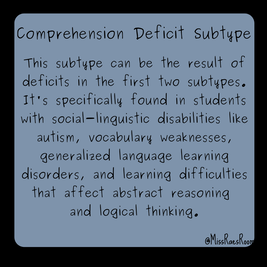 Another single deficit is a Comprehension deficit. Comprehension Deficit: This subtype can be the result of deficits in the first two subtypes. It's specifically found in students with social-linguistic disabilities like autism, vocabulary weaknesses, generalized language learning disorders, and difficulties in abstract reasoning and logical thinking. Click HERE to read more about these subtypes on my blog! The Impact of Dyslexia The impact of dyslexia varies from person to person due to its unique neurological profile. Regardless of the subtype, Dyslexia is a neurological disability, but the exact cause is still unclear. Despite this, brain imaging shows differences in the way a Dyslexic brain develops and functions. Specifically, Dyslexic brains have been found to have difficulties in identifying separate speech sounds within a word and/or learning how letters represent those sounds Dyslexia is not the result of the daily struggle of learning to read, but rather the result of a unique neurological profile. And as a result, the impact of Dyslexia is different for each person. Students with dyslexia may exhibit a single deficit in word recognition if they have a prominent and specific weakness in either phonological, naming speed or comprehension. On the other hand, if they demonstrate deficits in both phonological and naming-speed abilities, they are considered to have a double deficit. Double-deficit students are more common and present the most significant challenges in remediation. Their weaknesses impact the accuracy of reading words, fluency in reading sentences and passages, and overall reading comprehension. It's crucial to identify and understand these subtypes to provide targeted support and interventions that address the specific needs of each individual. By understanding the major reading disabilities, specifically dyslexia and its subtypes, teachers can provide targeted interventions and support that address the specific needs of students with learning differences. Empowering students with the necessary tools and strategies will pave the way for their reading success. Remember, every student is unique, and personalized support plays a vital role in their academic growth. With the right strategies and interventions, we can create a supportive learning environment that enables all students to thrive in their reading skills. Happy & Healthy Teaching! PEACE, Miss Rae Related BlogsRelated Resources8/3/2023 2 Comments Where to Find Decodables: A Comprehensive Guide for Teachers of Students with Learning DisabilitiesDiscover a wide range of decodable books and resources for teaching reading to students with learning disabilities. Explore various sources such as educational publishers, online platforms, local libraries, and specialized phonics programs. Enhance your instruction with explicit and systematic phonics resources aligned with your teaching goals. In the journey of teaching reading to students with learning disabilities, decodable books play a crucial role. These specially designed books contain words that are phonetically decodable, enabling students to apply their learned phonics skills. In this blog, we will explore various sources where teachers can find decodables to support explicit and systematic phonics instruction. Let's dive in and discover the wealth of resources available to enhance reading instruction for students with learning disabilities. FlyLeaf Publishing FlyLeaf Publishing offers a range of instructional resources, including decodable books, that align with explicit and systematic phonics instruction. Browse their collection to find decodable books tailored to different skill levels, ensuring a progression from simpler to more complex word patterns. Just Right Reader Just Right Reader provides an extensive e-library of decodable books, accessible online. Their digital collection offers a wide range of engaging stories designed to support phonics instruction and reinforce sound/spelling relationships. Your Local Library Your Local Library Your local library can be a valuable resource for finding decodable books. Talk to the librarian and inquire about their collection of decodables or ask if they can order specific titles. Collaborating with the local library expands the availability of decodable books beyond the classroom. Your School Library Advocate for the inclusion of decodable books in your school library's collection. Speak to the librarian or relevant decision-makers, explaining the importance of decodables in supporting students with learning disabilities. By incorporating decodable books into the school library, access to these valuable resources can be broadened for all students. Reading Street Series The Reading Street series offers a variety of decodable stories that align with explicit phonics instruction. Visit their website to access downloadable PDFs of decodable stories categorized by grade level, enabling targeted instruction for your students. Core Knowledge Core Knowledge provides a free PDF resource containing decodable books for early readers. These books are specifically designed to support systematic phonics instruction, offering carefully selected word patterns that gradually build upon existing skills. Additional Core Knowledge decodables can be found HERE, HERE, and HERE. Jolly Phonics Jolly Phonics, a renowned phonics program, offers a range of decodable books authored by Sara Wernham. These books provide engaging stories that align with the program's systematic approach, making them an excellent resource for reinforcing phonics skills. Half Pint Kids Half Pint Kids offers a collection of online decodable books and resources. Their materials are designed to support early readers in developing phonics skills, with a focus on explicit instruction and word decoding practice. Spelfabet Spelfabet provides a range of decodable books and resources that align with explicit phonics instruction. Their decodable books are structured to gradually introduce new sound/spelling relationships, reinforcing the logic of the alphabetic principle. Miss Rae's Room Decodables And click HERE to use my decodables in your teaching! Finding decodable books to support the reading instruction of students with learning disabilities is essential for promoting their reading success. By exploring the diverse sources mentioned above, such as educational publishers, online platforms, local libraries, and specialized phonics programs, teachers can access a wide array of decodable books aligned with explicit and systematic phonics instruction. Click HERE to use my decodables in your teaching! Empower your teaching with these valuable resources and help your students develop strong reading skills based on sound phonetic knowledge. Remember, using decodables in conjunction with explicit and systematic phonics instruction provides a solid foundation for students with learning disabilities to become confident and independent readers. Now that you know where to find decodables, take the next step and enhance your reading instruction to unlock the potential of every student in your classroom! And read more by clicking HERE about decodables on my blog - What is a Decodable? Happy Teaching! PEACE, Miss Rae Related BlogRelated ResourceEnhancing Phonological Awareness in Students with Learning Disabilities: Effective Strategies for Reading Development. Discover key techniques for building phonological awareness skills in students with learning disabilities. From rhyming activities to sound segmentation exercises, explore practical strategies to strengthen phonemic proficiency and unlock the foundation for fluent reading and vocabulary growth. Empower students with the essential phonological awareness skills necessary for skilled comprehension. A must-read guide for teachers seeking effective approaches to support reading development in students with learning disabilities Embarking on the journey of reading begins with a fundamental understanding of phonological awareness. This crucial skill encompasses the recognition that written words align with their spoken counterparts. In essence, it is the gateway to seamlessly transitioning from printed words to spoken language (reading) and vice versa (spelling) (Moats, 2010). Join us as we delve into the transformative potential of phonological awareness, illuminating its pivotal role in paving the way for reading success. Phonological awareness encompasses various skills, including word, syllable, onset, rime, and phoneme awareness. It plays a crucial role in learning to read any alphabetic writing system (Ehri, 2004) and serves as the foundation for developing phonics skills. The ability to decode (convert print to speech) and encode (convert speech to print) words effectively relies on students' capacity to identify individual sounds, or phonemes, within spoken language (National Reading Panel, p. 14). Developing phonemic awareness is Students with learning disabilities often face challenges in phonological awareness, which can significantly impact their reading abilities. Therefore, it is essential to focus on building strong phonological awareness skills to establish a solid reading foundation. Importance of Phonemic Proficiency for All Readers:Phonemic proficiency serves as the basis for unlocking orthographic mapping, which is crucial for word recognition, fluent reading, vocabulary development, and comprehension (Kilpatrick). Developing phonemic awareness is necessary for skilled reading. Strategies for Developing Phonological Awareness Skills:1-Practice Rhyming:Young children naturally develop a sense of rhyming even before starting school, indicating an innate ear for rhyming structure (Adams, 1990, p. 80). Rhyming serves as the initial step in teaching phonological awareness and sets the stage for early reading development. Read rhyming stories and poems aloud, emphasizing the sounds of rhyming words and encouraging students to predict the next word. Incorporate rhyming songs and chants into daily activities to reinforce rhyming skills. Engage students in activities that involve manipulating, adding, deleting, or substituting sounds in words to practice identifying and producing rhymes. Recommended Rhyming Books:
2-Sound Awareness:Alliteration awareness involves recognizing the repetition of initial sounds in spoken words. Teachers should draw attention to repeated sounds while reading aloud, both during story time and in everyday situations. Encourage students to identify words starting with specific sounds, such as the /fffff/ sound in "fish." 3-Syllable Awareness:Syllable awareness involves identifying, blending, and segmenting syllables within spoken words. Introduce syllable awareness before students are introduced to written words to develop their understanding of spoken syllables. Engage students in finger counting, blending syllables, clapping, or using manipulatives like chips or blocks to represent each syllable. Implement the "chin dropping" technique, where students place their hands under their chin and feel the syllables as they say a word. For more in-depth information on teaching syllables and related strategies, you can read my blog post on syllable types HERE. 4-Onset-Rime Awareness:Onset-Rime Awareness involves recognizing, blending, and segmenting the initial consonant sounds (onset) and the remaining vowel and phonemes (rime) within spoken words. Help students segment familiar one-syllable words into onsets and rimes and manipulate them to create new words. Highlight the exchange of onsets in rhyming words (e.g., sat/mat/fat, gift/lift, pop/hop/top) and the various rime patterns (e.g., -o in go/so, -oat in coat/moat, -ag in sag/tag). 5-Sound Segmentation:Sound segmentation involves breaking words into individual sounds (phonemes). Use picture cards or cut-outs to prompt students to match the initial or final sounds in words. Encourage physical actions like tapping or stomping for each sound or provide sound tokens for students to move into a box as they hear each sound. Sound segmentation lays the foundation for blending sounds during reading. To explore a suggested order for teaching phonemic awareness skills and additional strategies, check out THIS blog post on a scope and sequence for reading skills. And here are a few more fun activities to enhance your instruction: 🎶 "Sing it Out Loud!" 🎤 Who doesn't love a good sing-along? Encourage your students to sing nursery rhymes, catchy jingles, and even their favorite songs. It's not just for fun; it actually helps them recognize and manipulate sounds effortlessly. 🕵️♂️ "I Spy with My Little Ear 👂" Remember the classic game "I Spy"? It's not just for long car rides! Play this clever game in the classroom, emphasizing initial sounds like the beginning letter of words. Your little detectives will be masters at spotting sounds in no time. 🧩 "Phonics Puzzlers" 🧩 Puzzles aren't just for rainy days! Create word puzzles that focus on different sounds and let your students piece them together. It's like solving a mini-mystery with each word they master. 👥 "Team Tongue Twisters" 👅 Round up your students and challenge them to tongue twisters! These fun phrases not only entertain but also help develop their sound blending skills. Bet you can't say "silly Sally swiftly shooed seven silly sheep" five times fast! 📚 "A Whole New World of Books" 🌍 Bring on the books! Choose texts with repetitive sounds or rhymes, and let your students take the lead in reading aloud. This not only builds confidence but also reinforces their phonological awareness skills. Remember, each student is on their unique journey, and your support and encouragement can make all the difference! Phonemic Awareness:Phonemic awareness, the ability to identify, blend, segment, and manipulate individual sounds (phonemes) in spoken words, is the most critical aspect of phonological awareness for early reading development. It is essential to provide oral activities to develop phonemic awareness before introducing sound-symbol correspondences during phonics instruction. By focusing on these key strategies, teachers can effectively build phonological awareness skills in students with learning disabilities, empowering them to become confident readers. Happy Teaching! Miss Rae Related Blogs...Related Resources...7/12/2023 2 Comments Boost Reading Fluency with RAN Board Drills: A Coordinated Approach for TeachersDiscover how RAN Board Drills can significantly improve reading fluency in students. Learn how to implement a coordinated approach, including structured literacy instruction, advanced phonemic awareness skills, explicit phonics instruction, and engaging RAN drills using RAN boards. Enhance automaticity, decoding skills, and reading tracking while empowering students with the tools to become fluent readers. Get ready to elevate your teaching and witness remarkable progress in reading fluency! Are you searching for an effective method to enhance your students' reading fluency? Look no further! In this blog, we'll dive into the world of Rapid Automatized Naming (RAN) and introduce you to a powerful tool that can revolutionize your teaching approach: RAN Board Drills. In this era of advancing literacy instruction, RAN has emerged as a key predictor of students' fluency and overall reading abilities. But what exactly is RAN, and how does it impact reading proficiency? Whether you're a seasoned educator or a passionate parent, understanding the impact of RAN on reading skills is crucial. So let’s get some knowledge to enhance our teacher powers! What is Rapid automatized naming (RAN)?: Rapid automatized naming (RAN) is a task that measures how quickly students can name aloud objects, pictures, colors, or symbols (letters or digits). RAN is considered to be a strong predictor of a student’s fluency and later ability to read. In particular, RAN for letters and digits (numbers) correlate more strongly with reading skills. Poor RAN is often associated with reading difficulties in students. RAN is a great predictor of success, but it is not what you need to teach because well, we can’t really. Research has shown that RAN training does not improve reading. But while research suggests that RAN training alone may not directly improve reading skills, there are strategies that can enhance overall fluency and integrate reading skills for students with lagging RAN skills. Maryanne Wolf has concluded that if you want students to demonstrate fluent comprehension, teachers must first, implement a structured literacy approach to reading and second, teach with an emphasis on a coordinated approach to reading fluency. Structured Literacy Approach to Reading:The Structured Literacy approach to reading is considered to be the best methodology for improving students’ oral reading fluency. Implement a systematic and explicit approach that focuses on teaching the structure of language, including phonology, morphology, and syntax. This approach provides structured instruction in phonemic awareness, phonics, and decoding skills to develop a strong foundation for reading. Teaching oral reading fluency through activities like repeated reading, Wolf argues, may show a positive effect on fluent reading, but it may only lead to faster reading, rather than more coordinated or fluent reading.  At the word-level, readers must attend to the individual word in a text. Word-Level reading skills are based upon phonological/phonemic skills. Poor access to phonemes in spoken words negatively affects reading development. Such difficulties affect phonic development, sight word acquisition, and fluency. So our intervention instruction must be that coordinated approach to teaching reading fluency that Wolf references. Coordinated Approach to Reading Fluency: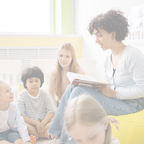 A coordinated approach to reading fluency should target automaticity of advanced phonemic awareness skills, explicit instruction in lagging phonics skills, direct fluency instruction, and include RAN charts, word part and word drills, memory strategies, and games! One way, in particular, to improve a student’s weak RAN skills’ impact on reading is to implement RAN Drills using RAN boards! RAN Drills:RAN drills target automaticity with word reading for students. The goal is for a student to see a word and be able to automatically read it. When a student encounters an unfamiliar word, the goal shifts to being able to efficiently and quickly decode it using acquired skill knowledge. This improves students’ reading fluency, which also improves students’ reading comprehension. Once students learn a phonics concept like the letter combinations of c and h make the /ch/ sound like in the word chat, they should practice this skill so that it becomes automatic. Drills for automaticity can support this. Start with letter-sound correspondence drills. Then, move to words containing the learned skill (and include previously learned skills in the words only). So if a student knows the consonant and short vowel sounds to date include words like /chat/, /much/, and /chin/, but do not include words like /change/ or /cherries/. Once word automaticity is strong, move to phrase (i.e. /such luck/), sentence (i.e. /I had such luck./) and then, paragraph reading using decodables with the learned skill. RAN Board Drills: RAN Boards are a tool teachers can use to teach reading fluency. RAN Boards can be utilized to enhance automaticity in letter-sound correspondence, word parts (such as /am/ and /ip/), and whole words that incorporate previously learned skills. This helps students improve their retrieval of information, or automaticity! The basic idea of RAN Board Drills is that you have a limited amount of items on the board and that they repeat over and over. Students practice reading the entire chart as fast as they can. You can time students, and track their time for progress monitoring. You can read more about how to progress monitor students HERE on my blog: Progress Monitoring Special Education Students It is really like giving students a stack of flashcards, but with the same letters, word parts, words, phrases, or sentences written several times on lots of different flashcards for lots of practice. The difference is that RAN boards also embed book or text reading skills by having students read the letters, word parts, or words from left to right, supporting their reading tracking. You can use THIS template to create your own RAN Board Drills or grab some pre-made ones for consonants and vowels HERE and CVC words HERE! In conclusion, RAN Board Drills emerge as an indispensable tool, igniting the flames of students' reading fluency and propelling them towards remarkable progress. When coupled with the power of a Structured Literacy approach to teaching reading, the impact is truly transformative. Through the systematic integration of RAN Board Drills, students embark on a journey of accelerated growth, witnessing significant improvements in their overall reading success. With each drill, students unlock the door to fluency, enabling them to navigate the written word with ease, confidence, and unwavering comprehension. The harmonious synergy between RAN Board Drills and a Structured Literacy approach lays the foundation for a brighter future, where every student can embrace the joys and rewards of reading with open arms. Happy & Healthy Teaching! Miss Rae Related Resources...Related Blogs...6/22/2023 1 Comment Rapid Automatized Naming (RAN): Understanding Its Impact on Reading and Strategies for ImprovementDiscover the impact of Rapid Automatized Naming (RAN) on reading skills and effective strategies to improve student's RAN skills. Explore the importance of fluency and learn how to redefine fluency instruction for students with dyslexia. Implement proven approaches, such as structured literacy, phonics instruction, explicit fluency techniques, and memory strategies, to enhance overall reading fluency. Unlock the potential of students with dyslexia and empower them on their reading journey. Rapid automatized naming (RAN) is a task that measures how quickly students can name aloud objects, pictures, colors, or symbols (letters or digits). It has been identified as a strong predictor of a student's fluency and later reading ability, especially when it comes to letters and digits. Poor RAN scores are often associated with reading difficulties in students. In this article, we will define RAN, explore the impact of RAN on reading skills, and learn strategies to improve student's RAN skills. What is RAN?
Assessing RAN
RAN screeners like THESE can be used to informally assess a student’s RAN. By utilizing these assessments, educators and professionals can gain valuable insights into a student's Processing Speed abilities, identify areas of strengths and weaknesses, and make informed decisions regarding appropriate interventions and accommodations. Understanding the Impact of RAN on Reading:Slower-than-average RAN scores are often linked to struggles with word-level reading. Word-level reading requires readers to attend to individual words in a text, which is based on phonological and phonemic skills. Difficulties in accessing phonemes in spoken words can negatively affect reading development, including phonics, sight word acquisition, and fluency. Skilled word-level reading is a crucial gateway to achieving overall fluency, and research has shown that a student's vocabulary size significantly influences their fluency. Challenges and Strategies for Students with Dyslexia:
Strategies for Improving RAN Skills:So how can we teach RAN to improve students' reading? Research says we can’t. Well, kind of. Let me explain… While research suggests that RAN training alone may not directly improve reading skills, there are strategies that can enhance overall fluency and integrate reading skills for students with dyslexia. The Structured Literacy approach to reading is considered to be the best methodology for improving students’ oral reading fluency. Implement a systematic and explicit approach that focuses on teaching the structure of language, including phonology, morphology, and syntax. This approach provides structured instruction in phonemic awareness, phonics, and decoding skills to develop a strong foundation for reading. At the word-level, readers must attend to the individual word in a text. Word-Level reading skills are based upon phonological/phonemic skills. Poor access to phonemes in spoken words negatively affects reading development. Such difficulties affect phonic development, sight word acquisition, and fluency. So our intervention instruction should target automaticity of advanced phonemic awareness skills, explicit instruction in lagging phonics skills, direct fluency instruction, and include RAN charts, word part and word drills, memory strategies, and games! Intervention Instruction Components:
Password, Scattergories, Taboo, Pictionary, Boggle, Crosswords, and Charades can engage students and provide opportunities for quick thinking and retrieval of information. By combining these strategies and approaches, teachers can provide targeted instruction to improve fluency skills while integrating reading skills effectively. While RAN training alone may not directly improve reading skills, it is possible to enhance overall fluency for students with dyslexia by implementing specific instructional strategies. By prioritizing the development of a sight vocabulary, comprising both phonetically regular and irregular words, students can improve their instant recognition and reading of familiar words. Remember that fluency should be defined based on individual student needs, focusing on achieving a moderate rate and expression when reading. By understanding the impact of RAN on reading and employing effective strategies, we can support students in becoming confident and proficient readers. Happy & Healthy Teaching! Miss Rae Related Resources...Related Blogs... |
CategoriesAll Comprehension CoPlanning CoTeaching Directed Reading DIY Fluency Fountas & Pinnell Graphic Organizers Guided Reading Lesson Planning Multi-Tiered Systems Of Support Phonological Awareness RAN Read And Respond Reading Reading Assessments Reading Comprehension Response To Intervention RTI Science Of Reading Science Of Reading For Special Education Teachers Special Education Special Education Eligibility Special Education Lesson Planning Teaching Strategy Visualizing & Verbalizing Visual Texts Vocabulary Writing Writing In Response To Reading |
















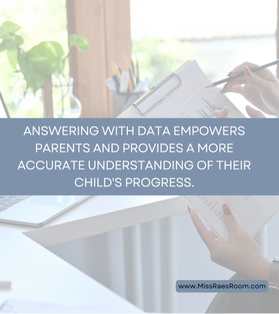


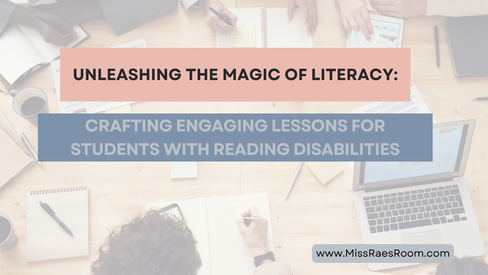












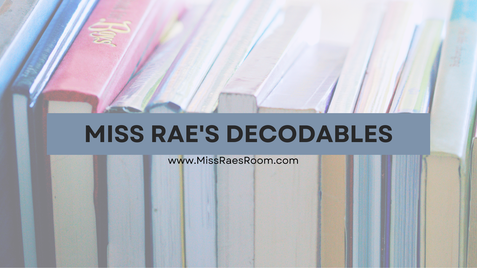





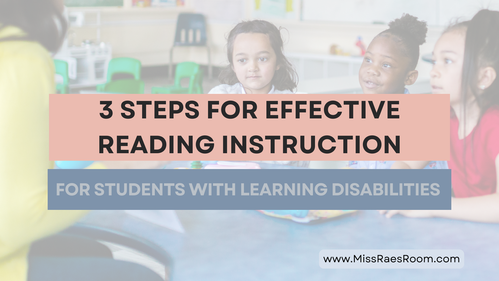







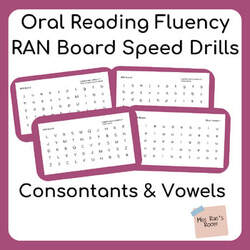







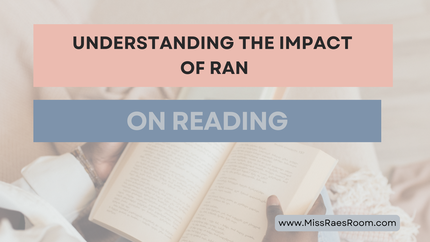


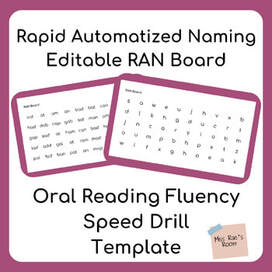



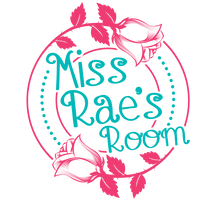
 RSS Feed
RSS Feed